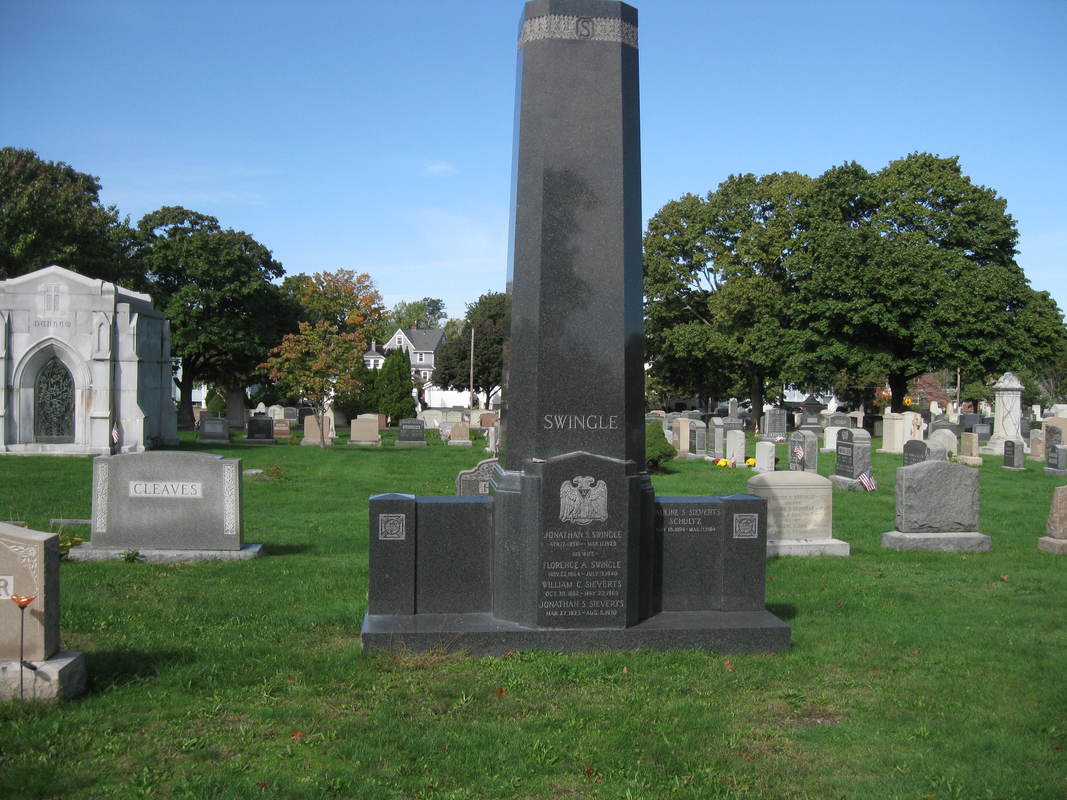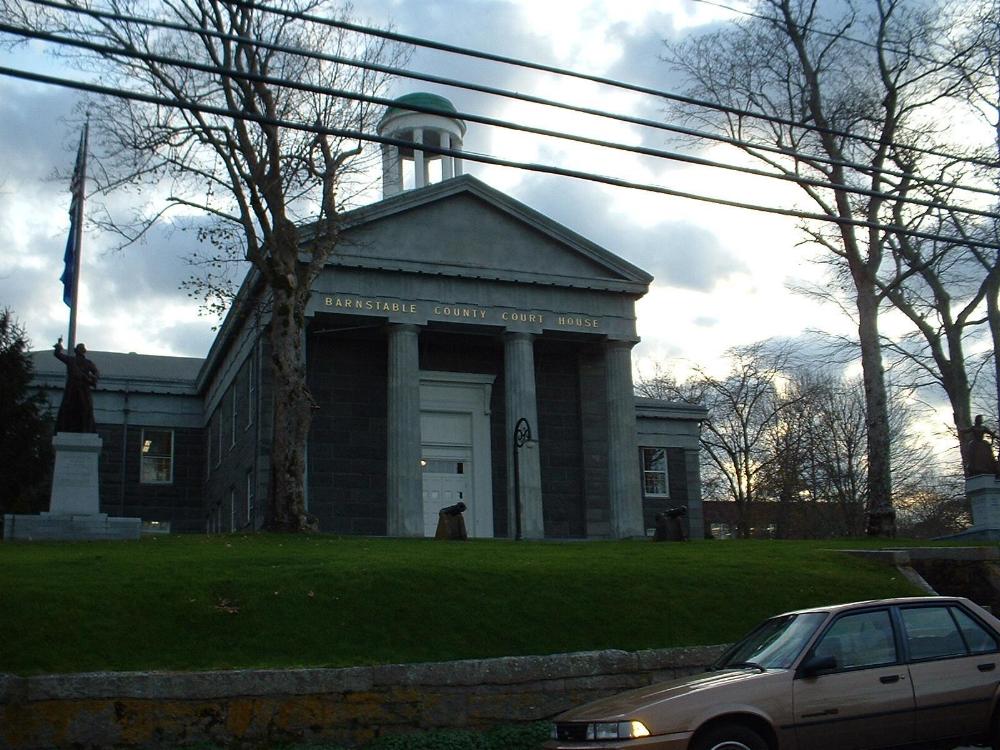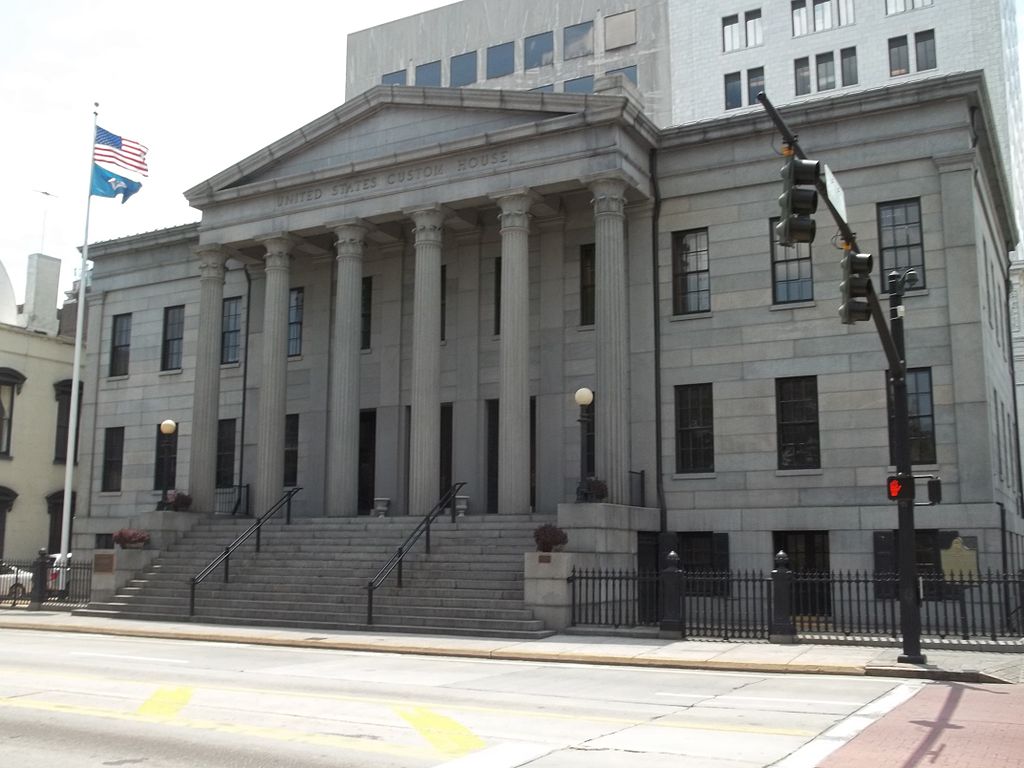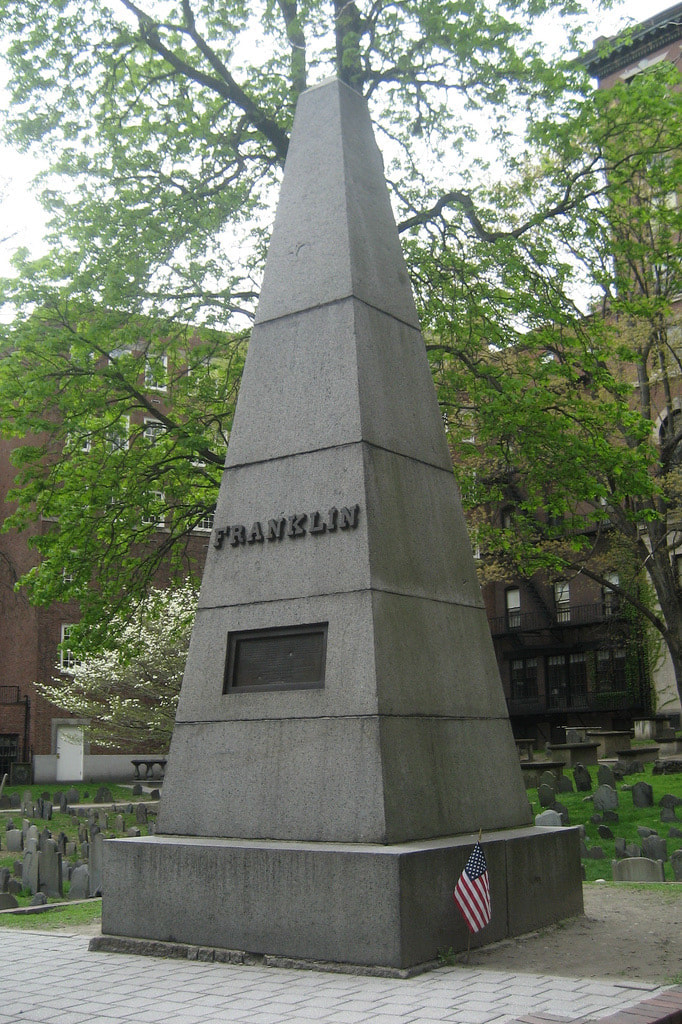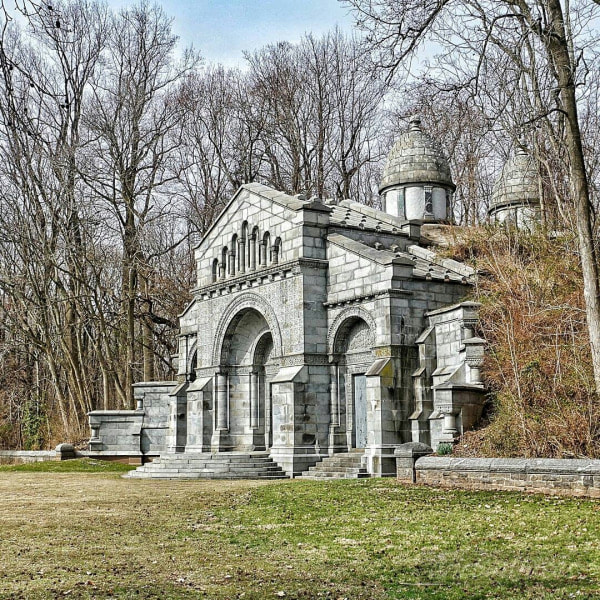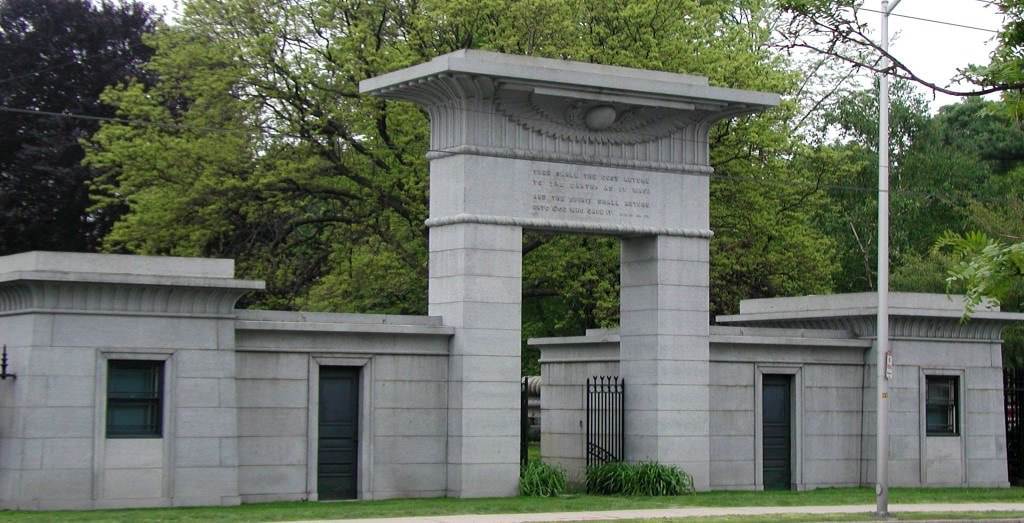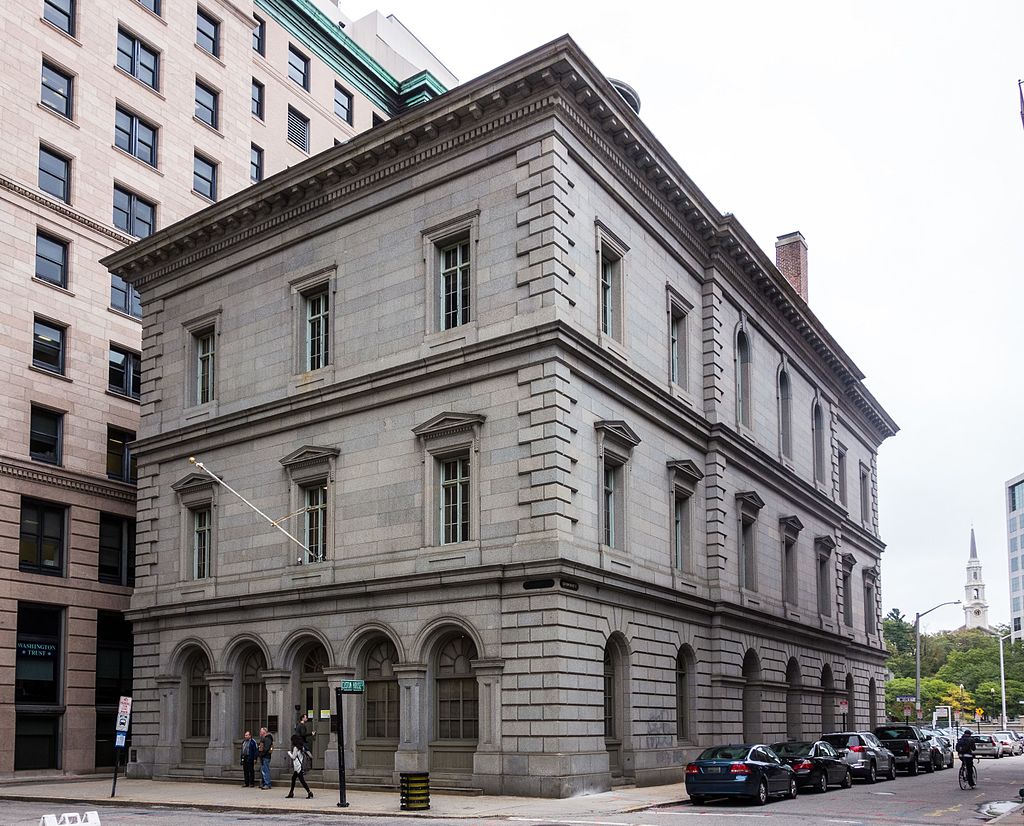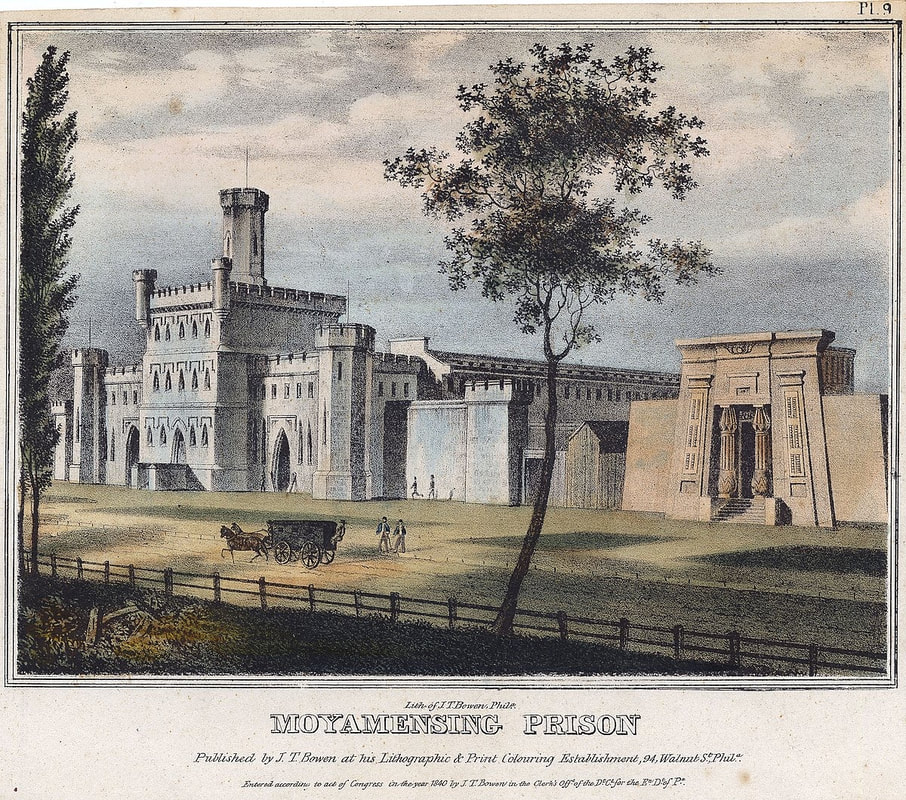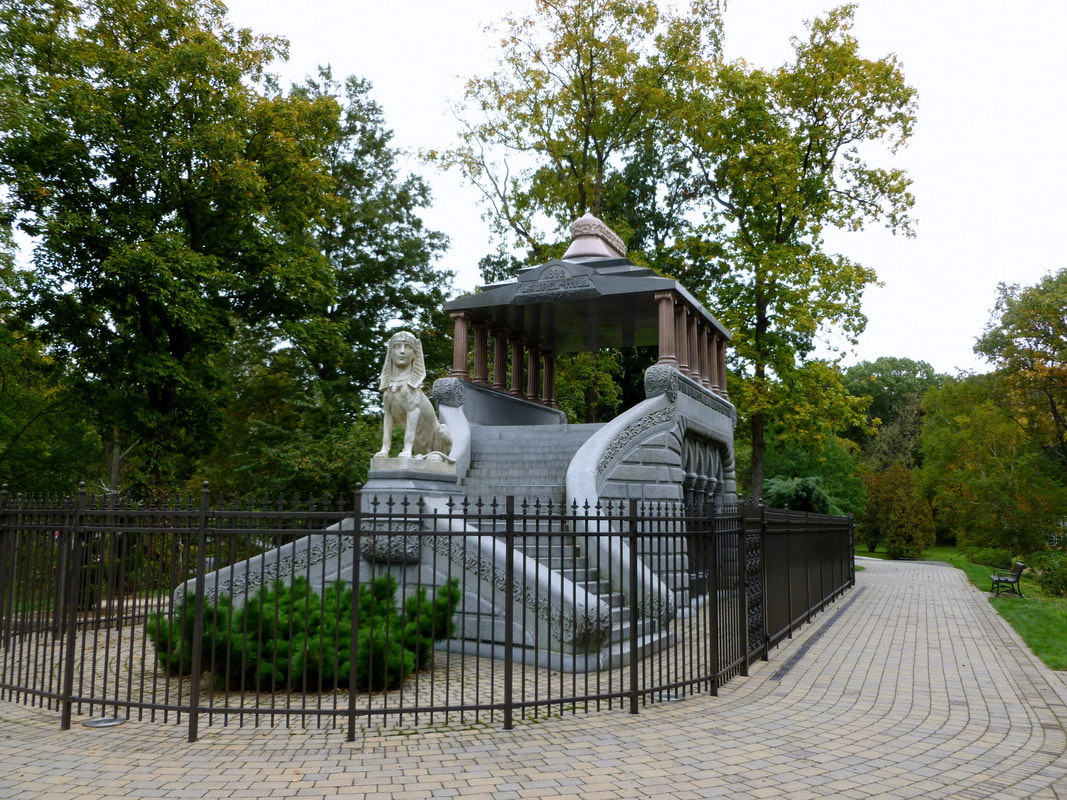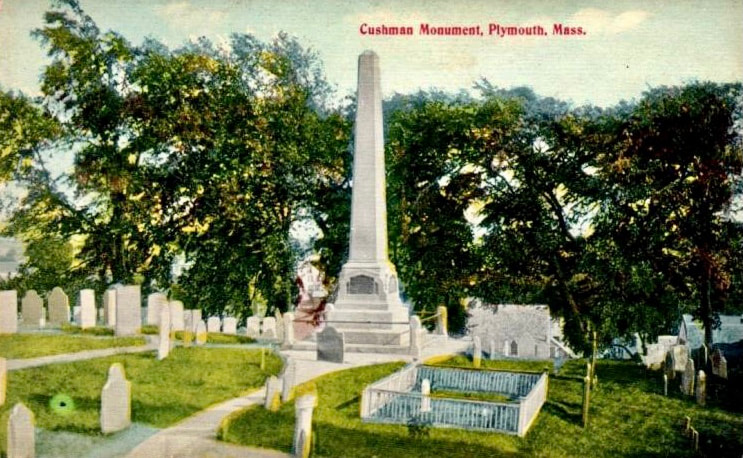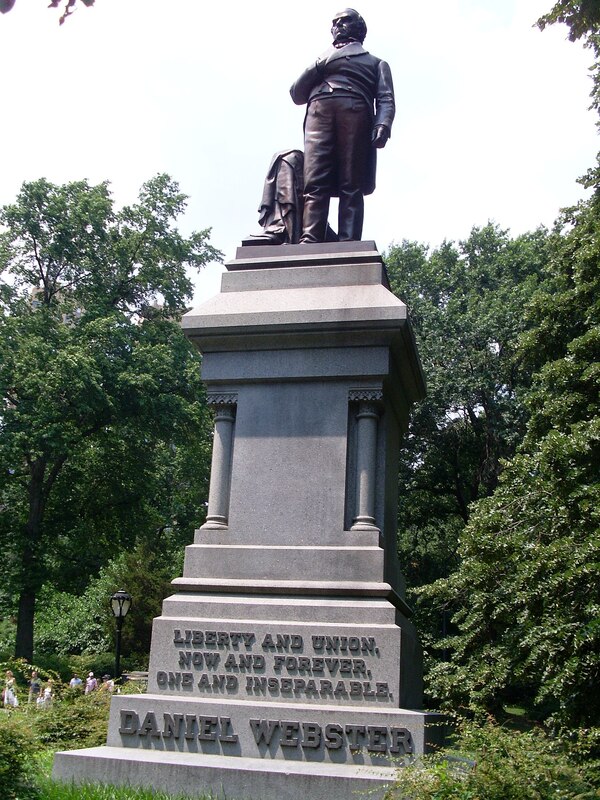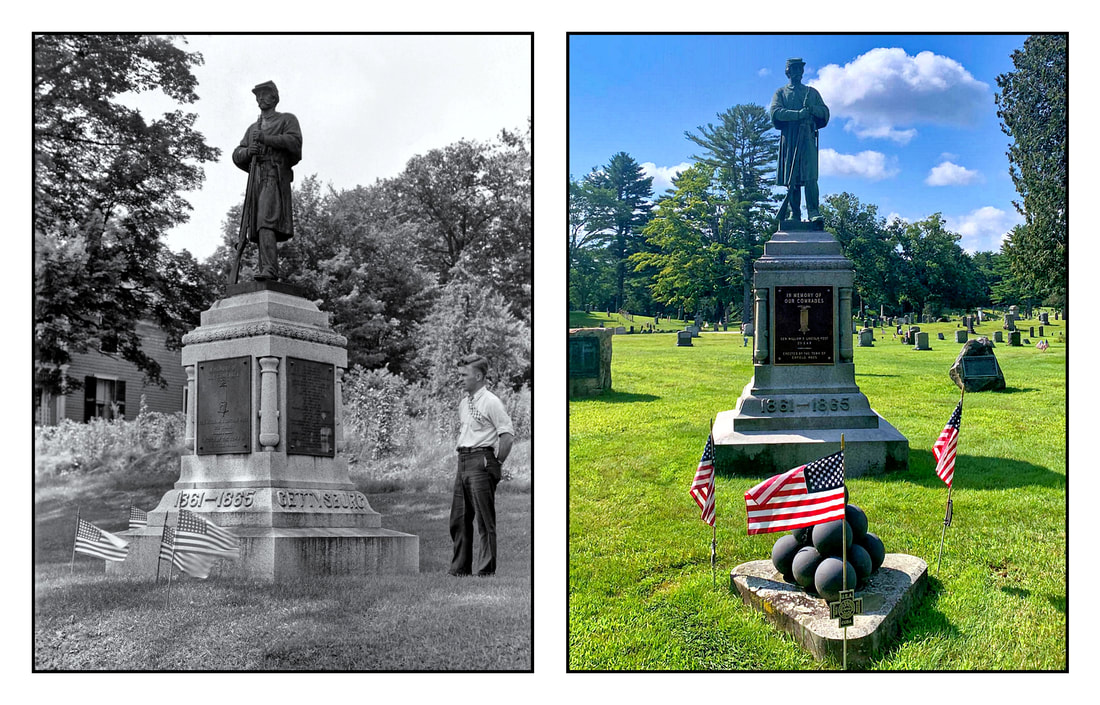Where is Quincy Granite?
The Gazing Ball, a shining sphere of Quincy Granite moved from Constitution Common outside city hall to it's new temporary location, still in constitution common, to make way for the Adams Green. Which will run between city hall and the Church of the Presidents.
At the town meeting of February 9, 1844 a committee was chosen to procure a suitable plan for a new Town House of wood or stone. On April 18, 1844 Solomon Willard was added to the building committee and accepted the appointment of architect and superintendent of construction. A town meeting was called on April 20, 1844 to reconsider the vote of a previous meeting to build the new Town House of wood and now that it be built of stone. Construction began on April 27, 1844 and was completed on November 1, 1844
The Inclined Plane Railway designed and built by Gridely Bryant in 1828 for the Granite Railway Conpany. Its purpose was to transport granite down from Pine Hill Ledge to the Granite Railway for transport to the wharf at Gullivers Creek and the Neponset River for shipment by granite sloops.
The beautiful granite entrance to the new Central Middle School auditorium originally was the north entrance of the old Central Middle School. It was determined by the City of Quincy that this impressive Quincy granite entrance should be incorporated into the new Central Middle School. The contractor carefully disassembled the entrance and reassembled it at the entrance to Central's new auditorium. The doorway entrance is light to medium Quincy granite witih a beautifully carved laurel wreath and cornucopias. The granite manufacturer and sculptor is unknown to date.
Swingle Monument in Mount Wollaston Cemetery is an example of extra dark Quincy granite from the J.S. Swingle quarry inWest Quincy.
The Stone Temple designed and erected in 1827-28 by architect - engineer Alexander Parris, has been known as United First Parish Church, the Stone Temple and Church Of The Presidends was constructed in the Greek Revival style and built of Quincy Blue granite. The bulk of the granite for the church came from the Adams family quarry.
The Granite Trust Building designed by J. Williams Beal & Sons and constructed in 1929 was the tallest building in Quincy at that period. The ground level building facade is of dark Quincy granite from the Hitchcock Quarry that was owned by a group that included Theophilus King the president of the Granite Trust Bank in 1929.
Pilgrim Hall Museum
The Pilgrim Hall Museum is the nations oldest continuously operating Museum, located in Plymouth, Massachusetts. The Pilgrim Hall Museum was designed by Alexander Paris and built of Quincy granite and opened in 1824. In 1922 the original wooden portico was replaced by the present granite six- column Greek Revival Temple front design.
The Pilgrim Hall Museum is the nations oldest continuously operating Museum, located in Plymouth, Massachusetts. The Pilgrim Hall Museum was designed by Alexander Paris and built of Quincy granite and opened in 1824. In 1922 the original wooden portico was replaced by the present granite six- column Greek Revival Temple front design.
Barnstable County Courthouse
The Barnstable County Courthouse is a historic courthouse in Barnstable, Massachusetts located on Mass. route 6A also known as (The Old Kings Highway). The two-story Greek revival building was built in 1831 and designed by architect Alexander Paris. Built out all large Quincy granite blocks except for the front portico and fluted Doric columns are made out of wood fashion to look like stone. All of the expansions to the courthouse continued to use Quincy granite.
The Barnstable County Courthouse is a historic courthouse in Barnstable, Massachusetts located on Mass. route 6A also known as (The Old Kings Highway). The two-story Greek revival building was built in 1831 and designed by architect Alexander Paris. Built out all large Quincy granite blocks except for the front portico and fluted Doric columns are made out of wood fashion to look like stone. All of the expansions to the courthouse continued to use Quincy granite.
King’s Chapel
The original Kings Chapel was a wooden church built in 1688 at the corner of Tremont and School Streets Boston. In 1749 construction began on the current stone structure designed by Peter Harrison in the Georgian-Style of architectural and was completed in 1754. The stone church was built around the wooden church and when the stone church was completed, the wooden church was disassembled and removed through the windows of the new stone church. The stone church built of gray Quincy granite that was quarried in 1749, in what was known as the Braintree Commons, which later became the town/city of Quincy, Massachusetts
The original Kings Chapel was a wooden church built in 1688 at the corner of Tremont and School Streets Boston. In 1749 construction began on the current stone structure designed by Peter Harrison in the Georgian-Style of architectural and was completed in 1754. The stone church was built around the wooden church and when the stone church was completed, the wooden church was disassembled and removed through the windows of the new stone church. The stone church built of gray Quincy granite that was quarried in 1749, in what was known as the Braintree Commons, which later became the town/city of Quincy, Massachusetts
Minot’s Ledge Lighthouse
Minot’s Ledge lies about a mile off shore near the line between the South Shore towns all Cohasset and Scituate and is part of the dangerous Cohasset rocks. The construction of the present lighthouse was started in April 1855 and completed on June 29, 1860. The lighthouse was designed by Brevet Major General Joseph Gilbert Totten of the Army Corps of Engineers. Building construction was supervised by Capt. by Captain Barton Stone Alexander of the engineering core. The lighthouse consists of 1079 dovetail granite blocks that were quarried from the granite railway company quarry in West Quincy at a total cost of $300,000.
Minot’s Ledge lies about a mile off shore near the line between the South Shore towns all Cohasset and Scituate and is part of the dangerous Cohasset rocks. The construction of the present lighthouse was started in April 1855 and completed on June 29, 1860. The lighthouse was designed by Brevet Major General Joseph Gilbert Totten of the Army Corps of Engineers. Building construction was supervised by Capt. by Captain Barton Stone Alexander of the engineering core. The lighthouse consists of 1079 dovetail granite blocks that were quarried from the granite railway company quarry in West Quincy at a total cost of $300,000.
U.S. Custom House in Savannah, Georgia symbolizes George's import export trade in the 18th and 19th century. The cornerstone was laid on July 20, 1848, and completed in 1852 and was designed by John S. Norris, who also supervise its construction. The building Greek Revival design is 11 bays wide by five bays deep and constructed of 32 inch blocks of load-bearing, gray granite stone quarried in Quincy, Massachusetts. A pedimented portico supported by six monolithic granite columns dominate the main façade. These columns, estimated to weigh between 15 and 20 tons each were shipped from Quincy, Massachusetts lashed to the decks granite sloops. It reportedly took 30 days to transport the columns from Quincy to the site and an additional 30 days to raise them into position. The fluted columns have capitals elaborately carved with a tobacco leaf motif.
Dark Quincy monument is located in West Brookfield Mass. erected in 1921 to honor veterans from the Civil War, Spanish-American War and World War One
Thomas Jefferson monument in Louisville Kentucky erected in 1899 base dark Quincy granite from the Hitchcock quarry
Memorial erected in 1826 at The Old Granary Burial Grounds Boston MA. for Benjamin Franklin's parents. Design by Solomon Willard and built of granite from the Bunker Hill quarry Quincy MA.
Soldiers & Sailors Monument Troy New York 50 foot Quincy granite column plus base quarried at the Frederick & Field quarry and fabricated in their stone shed in Quincy Mass. in 1890.
Adams Academy Quincy Massachusetts built on land donated to the Town of Quincy by John Adams second president of the United States and formally the birthplace of John Hancock patriot and statesman. Built of Quincy granite construction began in 1868 and completed in 1870 under the direction of architect's Henry Van Brunt and William Robert Ware in the gothic revival style at a cost of $29,000. Adams Academy opened its doors in 1872 and operated until 1908, its peak enrollment was 140 students in 1876 – 77. The school was modeled after its football rivals Phillips Academy and Phillips Exeter Academy. There was a strong emphasis placed on classics and Adams students were prepared to attend Harvard.
Vanderbilt Family Mausoleum ,Moravian Cemetery New Dorp Staten Island
Constructed in 1885 it was designed by Richard M.Hunt of New York. It is Romanesque style and the dimensions are 100 by 110 feet by 63 feet high. The exposed portions are Quincy granite, while the vestibule and catacombs are built of marble. The arches and piers are made of limestone. It required 8 million lbs of stone and cost $250,000.00 to build. The contractor was McKenzie and Patterson Granite of Quincy MA. They had to hire an additional 100 men to complete the contract. McKenzie And Patterson had their stone shed on the Quincy Canal .
Constructed in 1885 it was designed by Richard M.Hunt of New York. It is Romanesque style and the dimensions are 100 by 110 feet by 63 feet high. The exposed portions are Quincy granite, while the vestibule and catacombs are built of marble. The arches and piers are made of limestone. It required 8 million lbs of stone and cost $250,000.00 to build. The contractor was McKenzie and Patterson Granite of Quincy MA. They had to hire an additional 100 men to complete the contract. McKenzie And Patterson had their stone shed on the Quincy Canal .
Mount Auburn Cemetery Cambridge MA. It was the the first garden cemetery in the United States, dedicated in 1831. The Entrance was built of Quincy granite to replace one made of wood. The Boston Atlas of 1843 gives the following description of it.
The new gateway and lodges are similar in design and correspond In size to the former ones. They are however of hammered Quincy granite instead of wood and are from the quarry of Octavias T. Rogers & Co. the contractors for the whole work. (O.T. Rogers & Co. was located where the Home Depot store is now on Willard St. West Quincy MA.)
The capstone of the gateway is undoubtedly the largest block of granite ever wrought. It is 24 feet 6 inches in length by 10 feet 9 inches in breath measuring to the outside faces of the abacus, and 4 feet 6 inches in height. The block from which this stone has been wrought weighed ,when first separated from the quarry,130 tons. It’s present weight is 55 tons. It was transported from Quincy to Watertown after being wrought ,on a carriage similar to those used in moving the columns ,and other large stones ,for the Custom House And Merchant’s Exchange (Boston) and drawn by 45 yoke of oxen.The lintel under the capstone is 18 feet long 4 feet wide and 4 feet 6 inches deep and weighs 27 tons. The cost of the whole work ,including an iron fence on each side of the lodges, 25 feet in length will be $10,000.00.
The new gateway and lodges are similar in design and correspond In size to the former ones. They are however of hammered Quincy granite instead of wood and are from the quarry of Octavias T. Rogers & Co. the contractors for the whole work. (O.T. Rogers & Co. was located where the Home Depot store is now on Willard St. West Quincy MA.)
The capstone of the gateway is undoubtedly the largest block of granite ever wrought. It is 24 feet 6 inches in length by 10 feet 9 inches in breath measuring to the outside faces of the abacus, and 4 feet 6 inches in height. The block from which this stone has been wrought weighed ,when first separated from the quarry,130 tons. It’s present weight is 55 tons. It was transported from Quincy to Watertown after being wrought ,on a carriage similar to those used in moving the columns ,and other large stones ,for the Custom House And Merchant’s Exchange (Boston) and drawn by 45 yoke of oxen.The lintel under the capstone is 18 feet long 4 feet wide and 4 feet 6 inches deep and weighs 27 tons. The cost of the whole work ,including an iron fence on each side of the lodges, 25 feet in length will be $10,000.00.
Mount Auburn Cemetery Cambridge MA. Washington Tower
Built of Quincy granite between 1852 and 1854. The architects were Dr. Jacob Bigelow and Gridley James Fox Bryant. The cost was about $20,000.00.
Built of Quincy granite between 1852 and 1854. The architects were Dr. Jacob Bigelow and Gridley James Fox Bryant. The cost was about $20,000.00.
Boston Custom House
Boston Custom House construction started in 1837 and was completed in 1847 at a cost of 1.076 million dollars. Designed by architect Ammi Burnham and constructed of Quincy granite with 36 columns each carved from a single piece of Quincy granite. Each column weighed 42 tons and cost about $5,200 each. Only half of these columns actually support the structure, the others are free standing. The columns are 5 feet 4 inches in diameter and 32 feet high. The tower was added by the federal government in 1913 through 1915. By 1905, increased shipping required the building's expansion. In 1913–1915, the architecture firm Peabody and Stearns added the tower to the base at a cost of 1.8 million. Although Boston at that time had a 125 ft (38 m) height restriction, the Custom House was federally owned and exempt from it. The new tower's 496 ft (151 m) made it the city's tallest. In 1947, the Old John Hancock Building, just one foot shorter, joined it in the skies over Boston. In 1964, it was exceeded by the Prudential Tower.[5]
U.S.Custom House Providence Rhode Island
Construction on the Custom House was started in 1855 and completed in 1857 in the Renaissance style by Ammi B. Young and built of granite from the quarries of Quincy at total cost of construction of $209,723.32. After completion it housed the cities Main Post Office, Federal District Court, District Attorney, Internal Revenue Service, Collector of Customs and Steamboat Inspector.
Construction on the Custom House was started in 1855 and completed in 1857 in the Renaissance style by Ammi B. Young and built of granite from the quarries of Quincy at total cost of construction of $209,723.32. After completion it housed the cities Main Post Office, Federal District Court, District Attorney, Internal Revenue Service, Collector of Customs and Steamboat Inspector.
New Orleans U.S. Custom House
Construction on this monumental granite building was begun in 1848 and built over a period of 33 years. Designed by architect Alexander Thompson Wood. In the 33 years a succession of eight architects follow, each modifying the original design concept. The buildings original design of Wood which included modified Greek and Egyptian Revival elements changed over the 33 years. The building was constructed of brick and sheathed in Gray Quincy granite. Construction was suspended during the Civil War, the building was occupied briefly by Confederate forces and then by the Union Army after New Orleans was occupied in 1862 and it was also use to house captured Confederate soldiers reportedly up to 2000 men at one time.
Construction on this monumental granite building was begun in 1848 and built over a period of 33 years. Designed by architect Alexander Thompson Wood. In the 33 years a succession of eight architects follow, each modifying the original design concept. The buildings original design of Wood which included modified Greek and Egyptian Revival elements changed over the 33 years. The building was constructed of brick and sheathed in Gray Quincy granite. Construction was suspended during the Civil War, the building was occupied briefly by Confederate forces and then by the Union Army after New Orleans was occupied in 1862 and it was also use to house captured Confederate soldiers reportedly up to 2000 men at one time.
Henry Ward Beecher Monument, Brooklyn New York 1891
Designed by American sculptor John Quincy Adams Ward (his other work includes the Ether Monument in the Boston Public Garden) A quote from the Bismarck Tribune of July 5th 1891 states “The statue is of bronze ,heroic size and stands firmly on a simple pedestal of dark Quincy granite”. According to the New York Parks Commission website ,this pedestal is Concord granite. The Granite Railway Company at this time had expanded and had a quarry in Concord New Hampshire, but this looks like it was indeed dark Quincy.
Designed by American sculptor John Quincy Adams Ward (his other work includes the Ether Monument in the Boston Public Garden) A quote from the Bismarck Tribune of July 5th 1891 states “The statue is of bronze ,heroic size and stands firmly on a simple pedestal of dark Quincy granite”. According to the New York Parks Commission website ,this pedestal is Concord granite. The Granite Railway Company at this time had expanded and had a quarry in Concord New Hampshire, but this looks like it was indeed dark Quincy.
Civil War Monument Hingham Massachusetts One example of the hundreds of monuments that honored those that lost their lives during the Civil War. This one is at Hingham MA and was designed and manufactured of Quincy granite by F.J. Fuller's Quincy Granite Co.
Dry Dock No. 1 Norfolk Virginia
The drydock was built between 1827 and 1834, and cost $974,365.65, a very high price at that time. It may have been designed by Loammi Baldwin,Jr, then the Navy's superintendent of drydocks, and its construction was overseen by William P. S. Sanger, a civil engineer. The granite was supplied by the Newcomb Brothers quarry located on the South Common area of Quincy / Braintree and some stone also came from the Granite Railway Company quarry in West Quincy. The dry dock was first used in June 1833, when USS Delaware was dry docked for recommissioning, the first time a large vessel was dry docked in the United States. During the American Civil War the shipyard was taken over by the Confederate Navy, and it was here that USS Merrimack was modified to become the ironclad CSS Virginia. It is now primarily used for service craft.
The drydock was built between 1827 and 1834, and cost $974,365.65, a very high price at that time. It may have been designed by Loammi Baldwin,Jr, then the Navy's superintendent of drydocks, and its construction was overseen by William P. S. Sanger, a civil engineer. The granite was supplied by the Newcomb Brothers quarry located on the South Common area of Quincy / Braintree and some stone also came from the Granite Railway Company quarry in West Quincy. The dry dock was first used in June 1833, when USS Delaware was dry docked for recommissioning, the first time a large vessel was dry docked in the United States. During the American Civil War the shipyard was taken over by the Confederate Navy, and it was here that USS Merrimack was modified to become the ironclad CSS Virginia. It is now primarily used for service craft.
Lincoln Park, Chicago,Illinois
Johann Christoph von Schiller monument erected in 1886 He was a German poet that wrote passionately about the value of freedom and ethics. The twelve foot bronze statue is a copy of many throughout the world and stands on a ten foot pedestal of Quincy granite.
Johann Christoph von Schiller monument erected in 1886 He was a German poet that wrote passionately about the value of freedom and ethics. The twelve foot bronze statue is a copy of many throughout the world and stands on a ten foot pedestal of Quincy granite.
Uniondale Cemetery Pittsburgh Pennsylvania. Thomas Duncan Mausoleum
Designed by Theophilus P. Chandler Jr. it was constructed of Quincy granite in 1878 for $30,000.00 . Mr. Duncan ,an Irish immigrant, made his fortune as an oil speculator in 1859 with leases he held in Pithole City, the birthplace of America’s oil industry. The monument is 75 feet high and is surmounted by a female figure to represent the “Recording Angel”. In the right hand she holds a pencil between the fingers and the left hand grasps a tablet.
Designed by Theophilus P. Chandler Jr. it was constructed of Quincy granite in 1878 for $30,000.00 . Mr. Duncan ,an Irish immigrant, made his fortune as an oil speculator in 1859 with leases he held in Pithole City, the birthplace of America’s oil industry. The monument is 75 feet high and is surmounted by a female figure to represent the “Recording Angel”. In the right hand she holds a pencil between the fingers and the left hand grasps a tablet.
Arlington Virginia , 2nd Connecticut Heavy Artillery Monument
At a cost of $1000.00 it was executed by Stephan Maslen and dedicated on October 21 1896. It is dark grey Quincy granite and was quarried and manufactured by F. Hardwick & Son Quincy MA.
At a cost of $1000.00 it was executed by Stephan Maslen and dedicated on October 21 1896. It is dark grey Quincy granite and was quarried and manufactured by F. Hardwick & Son Quincy MA.
Moyamensing Prison,Philadelphia, Pennsylvania . This should be titled “Where was Quincy Granite” as it was demolished in 1968.
Moyamensing Prison, designed by Thomas Ustick Walter,it was built of Quincy granite between 1832 and 1835. It was in use until 1963 . One prisoner that supposedly spent a night here was Edgar Allen Poe. The debtors apartment was in the Egyptian style of architecture and was built of brown sandstone.
Moyamensing Prison, designed by Thomas Ustick Walter,it was built of Quincy granite between 1832 and 1835. It was in use until 1963 . One prisoner that supposedly spent a night here was Edgar Allen Poe. The debtors apartment was in the Egyptian style of architecture and was built of brown sandstone.
Boston Naval Ship Yard the dry dock at Charlestown Massachusetts was designed by civil engineer Loammi Baldwin. Construction started in 1827 and completed in 1833 of stone furnished by the Granite Railway Company, which was in an excellent position to win the contract as they had just completed delivery of the first 3000 tons of hewn granite for the Bunker Hill Monument a short distance away. Both dry docks were of the same plan and required over 20,000 cubic yards of stone each , delivered to the site in blocks 6 to 8 feet long to be finished and fitted at the Navy Yards. They were the first dry docks constructed in the United States and having been enlarged over the years are still used today.
Civil War Soldiers Monument Mt. Zion Cemetery Ephrata Pennsylvania
Sacred to the memory of the patriotic soldiers of the American Revolution, who fought in the Battle of Brandywine, September 11, 1777 A. D. About 500 of the sick and wounded were brought to Ephrata for treatment. Several hundred died and were buried in this consecrated ground
Sacred to the memory of the patriotic soldiers of the American Revolution, who fought in the Battle of Brandywine, September 11, 1777 A. D. About 500 of the sick and wounded were brought to Ephrata for treatment. Several hundred died and were buried in this consecrated ground
The Barney Mausoleum Forest Park, Springfield MA.
Built for Everett Barney, the inventor of the clamp on ice skate.
The Quincy granite in this monument came from the Merrymount Quarry that was located where the Highpoint Complex is now on Quarry Street, Quincy MA.
Built for Everett Barney, the inventor of the clamp on ice skate.
The Quincy granite in this monument came from the Merrymount Quarry that was located where the Highpoint Complex is now on Quarry Street, Quincy MA.
Burial Hill, Plymouth MA.
Robert Cushman (1577~ 1625) Memorial. He was an important leader and organizer of the Mayflower voyage in 1620. The obelisk is Quincy granite , 25 feet high with bronze tablets. Although he is buried in England, his descendants erected this memorial in 1857. At that time the remains of his son and other family members were found and buried within a space below the monument. The monument was made by Charles R. Mitchell & Company Quincy MA.
Information from the files of Joe Chetwynd
Robert Cushman (1577~ 1625) Memorial. He was an important leader and organizer of the Mayflower voyage in 1620. The obelisk is Quincy granite , 25 feet high with bronze tablets. Although he is buried in England, his descendants erected this memorial in 1857. At that time the remains of his son and other family members were found and buried within a space below the monument. The monument was made by Charles R. Mitchell & Company Quincy MA.
Information from the files of Joe Chetwynd
Central Park New York , New York Daniel Webster Monument.
Erected in 1876, the bronze statue was designed by William Ball (1819-1911). The 30 ton Quincy granite base was from the Jonathan Williams Quarry, Quincy MA.
It was transported to New York by the Sloop Wm. P. Hunt , Captain William Derry Master, from Bracketts Wharf, Town River Quincy, MA.
(From the files of Joe Chetwynd )
Erected in 1876, the bronze statue was designed by William Ball (1819-1911). The 30 ton Quincy granite base was from the Jonathan Williams Quarry, Quincy MA.
It was transported to New York by the Sloop Wm. P. Hunt , Captain William Derry Master, from Bracketts Wharf, Town River Quincy, MA.
(From the files of Joe Chetwynd )
Danvers MA. Col. Israel Hutchinson
Erected in 1896 to honor a Revolutionary War hero, statesman and loyal citizen. Erected by his lineal descendants , it is six feet high and four feet wide and weighs about six tons. It cost $300.00 and is polished Quincy granite ,appropriately inscribed.
Erected in 1896 to honor a Revolutionary War hero, statesman and loyal citizen. Erected by his lineal descendants , it is six feet high and four feet wide and weighs about six tons. It cost $300.00 and is polished Quincy granite ,appropriately inscribed.
Elmwood Cemetery, Detroit Michigan Lewis Cass sarcophagus
Born on October 9 ,1782 in Exeter New Hampshire ,he died in 1860.
He was a military officer, politician,and statesman .
Granite was from Hardwick Quarry , Quincy MA.
Born on October 9 ,1782 in Exeter New Hampshire ,he died in 1860.
He was a military officer, politician,and statesman .
Granite was from Hardwick Quarry , Quincy MA.
Hall Cemetery , West Quincy MA. Ezra Badger
A small, but nicely polished dark Quincy memorial marks the last resting place of one of Quincy’s pioneer granite men. Ezra Badger was born in 1798 at Concord New Hampshire. He came to Quincy and at the age of 26 became Solomon Willard’s superintendent at the Bunker Hill Quarry during the construction of the monument. He then operated E.Badger & Sons until 1855 .At the age of 64 he enlisted in the Union Army as a wagoner and died from sickness at Seneca Falls Maryland. His sons Charles Louis and Leon C.carried on business as Badger Brothers as Granite Dealers and Machinists for many years in West Quincy. The Badger brothers not only were in the quarry and monument business ,but also made many types of machines used in the granite trade.
Hancock Cemetery , Quincy MA. Freeman Hunt Monument
Freeman Hunt monument. Freeman Hunt 1804 -1858 was a noted magazine publisher in nineteenth century New York, most known for being the editor of Hunt’s Merchant Magazine. This Quincy granite monument ,an obelisk 16 feet high is located near the graves of his mother and sister. Simple in form ,it stands on a gracefully curved base, ornamented with deep grooves, after the French style of rusticating . It was made at the McGrath , Mitchell & Co. stone shed Quincy, MA. (Raised Letters were an expensive touch in the days before pneumatic tools. ) From the files of Joe Chetwynd
Freeman Hunt monument. Freeman Hunt 1804 -1858 was a noted magazine publisher in nineteenth century New York, most known for being the editor of Hunt’s Merchant Magazine. This Quincy granite monument ,an obelisk 16 feet high is located near the graves of his mother and sister. Simple in form ,it stands on a gracefully curved base, ornamented with deep grooves, after the French style of rusticating . It was made at the McGrath , Mitchell & Co. stone shed Quincy, MA. (Raised Letters were an expensive touch in the days before pneumatic tools. ) From the files of Joe Chetwynd
315 Chestnut Street Philadelphia ,Pennsylvania. First National Bank Of Philadelphia erected in 1866 to 1867 ,the architect was John McArthur Jr. and the contractor was John Rice. The front is light Quincy granite.
Blocher Mausoleum, Buffalo, New York
Blocher Mausoleum located in Forest Lawn Cemetery, Buffalo New York, was light gray Quincy granite. The mausoleum was cut by the Mc Donnell and Sons Stone Works Conpany which was located in West Quincy at the corner of Garfield and Quarry streets. The interior portion of the mausoleum contains three marble statues. The McDonnell Company used a picture of the mausoleum in many of their adds in the trade magazines of the granite industry. An interesting story of the mausoleum is as follows.
THE STORY OF NELSON W. Blocher combines fact and folklore. The only son of John and Elizabeth Neff Blocher, he worked for his entire life in the family business selling dry goods and manufacturing clothing. This work, as well as solid investing and real estate deals, made the Blochers among the wealthiest families in Buffalo. Local legend claims that Blocher was enamored with Katherine, the young family maid, despite the disapproval of his parents (accounts differ if she returned his affection). Though the details of their relationship aren’t concrete, it’s known that their love story didn’t have a happy ending. Some stories suggest Blocher’s parents orchestrated an end to the relationship while he was in Europe. Others claim Katherine was sent away from the family home, and still more maintain that she chose to leave on her own accord. Without her, Blocher fell into depression and lost his health. He sought Katherine for years but was unsuccessful as his health grew worse. On his deathbed, he clutched the Bible that Katherine had left behind. When he died in 1884 at only 27 years old, it was believed that the cause was a broken heart. His parents, perhaps driven by guilt, set about honoring their only child with an elaborate mausoleum in Forest Lawn Cemetery. The senior Blocher was displeased by the artists he commissioned, allegedly because they insisted on a Neoclassical style where his son would be depicted in a toga. Instead, he designed the whole thing by himself. Despite being only an amateur, he was able to create an impressive structure using only 20 stones with 12 Doric columns holding an ornamented roof. Within the structure, enclosed by glass, are Italian Carrara marble statues depicting a romanticized scene of Blocher’s final moments. Blocher himself lies on a sarcophagus slab, clutching his Bible, while his parents look on. Above Blocher is an angel (possibly modeled after Katherine) who watches over him, or, perhaps calls him to heaven.
Blocher Mausoleum located in Forest Lawn Cemetery, Buffalo New York, was light gray Quincy granite. The mausoleum was cut by the Mc Donnell and Sons Stone Works Conpany which was located in West Quincy at the corner of Garfield and Quarry streets. The interior portion of the mausoleum contains three marble statues. The McDonnell Company used a picture of the mausoleum in many of their adds in the trade magazines of the granite industry. An interesting story of the mausoleum is as follows.
THE STORY OF NELSON W. Blocher combines fact and folklore. The only son of John and Elizabeth Neff Blocher, he worked for his entire life in the family business selling dry goods and manufacturing clothing. This work, as well as solid investing and real estate deals, made the Blochers among the wealthiest families in Buffalo. Local legend claims that Blocher was enamored with Katherine, the young family maid, despite the disapproval of his parents (accounts differ if she returned his affection). Though the details of their relationship aren’t concrete, it’s known that their love story didn’t have a happy ending. Some stories suggest Blocher’s parents orchestrated an end to the relationship while he was in Europe. Others claim Katherine was sent away from the family home, and still more maintain that she chose to leave on her own accord. Without her, Blocher fell into depression and lost his health. He sought Katherine for years but was unsuccessful as his health grew worse. On his deathbed, he clutched the Bible that Katherine had left behind. When he died in 1884 at only 27 years old, it was believed that the cause was a broken heart. His parents, perhaps driven by guilt, set about honoring their only child with an elaborate mausoleum in Forest Lawn Cemetery. The senior Blocher was displeased by the artists he commissioned, allegedly because they insisted on a Neoclassical style where his son would be depicted in a toga. Instead, he designed the whole thing by himself. Despite being only an amateur, he was able to create an impressive structure using only 20 stones with 12 Doric columns holding an ornamented roof. Within the structure, enclosed by glass, are Italian Carrara marble statues depicting a romanticized scene of Blocher’s final moments. Blocher himself lies on a sarcophagus slab, clutching his Bible, while his parents look on. Above Blocher is an angel (possibly modeled after Katherine) who watches over him, or, perhaps calls him to heaven.
MILTON-QUINCY BOUNDARY MARKER #6 Pictures of an old Quincy granite boundary stone marking the border between Quincy and Milton. It is located northwest of the Blue Hills Reservoir, a few hundred feet off Chickatawbut Road in the Blue Hills Reservation. The granite marker is almost 3’ in height, about 8” square, and sits on a platform of boulders. The letter “Q” (Quincy) is engraved on the east and south faces of the marker; an “M” (Milton) on the north face. It’s been here at least 120 years, probably longer. Credit Dana Smith friend of the Quarry Museum
Civil War Monument Enfield Mass.
The town of Enfield had a Civil War Memorial located on their town common. The monument was a gift from the local GAR Post and dedicated in 1916, however it was erected years earlier. In the late 1930's when the Quabbin reservoir was constructed the towns of Enfield, Greenwich, Dana and Prescott were demolished to make way for the reservoir. The Civil War monument along with all the gravestones were relocated to Quabbin Park Cemetery located in Ware, Mass. The base of the statue is of Quincy granite. Research by Museum member Dana Smith and photo by Elena Palladino
The town of Enfield had a Civil War Memorial located on their town common. The monument was a gift from the local GAR Post and dedicated in 1916, however it was erected years earlier. In the late 1930's when the Quabbin reservoir was constructed the towns of Enfield, Greenwich, Dana and Prescott were demolished to make way for the reservoir. The Civil War monument along with all the gravestones were relocated to Quabbin Park Cemetery located in Ware, Mass. The base of the statue is of Quincy granite. Research by Museum member Dana Smith and photo by Elena Palladino
Lauderdale Building , Providence, Rhode Island
The Lauderdale Building, Providence Rhode Island was designed by Stone, Carpenter & Willson and constructed in 1894. The design received national attention when it was published in the June 30, 1894 American Architect and Building News, which made mention of it's "fireproof" construction and the first story and cornice's use of polished dark Quincy granite. Information from Tom Bonomi
The Lauderdale Building, Providence Rhode Island was designed by Stone, Carpenter & Willson and constructed in 1894. The design received national attention when it was published in the June 30, 1894 American Architect and Building News, which made mention of it's "fireproof" construction and the first story and cornice's use of polished dark Quincy granite. Information from Tom Bonomi
